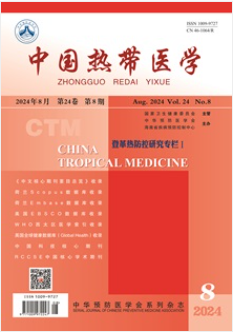杭州市西溪医院66例输入性疟疾临床特征分析
引用次数: 0
摘要
目的分析杭州市西溪医院2014年2月- 2019年12月疟疾患者的临床资料及药物治疗情况,为临床早期诊断、病情评估及治疗提供参考数据,促进临床合理用药。方法收集2014年2月至2019年12月收治的66例疟疾患者,区分轻、重度病例。比较两组患者的实验室检查结果及用药情况,采用多因素Logistic逐步回归分析两组指标。结果17例重症恶性疟疾患者采用青蒿琥酯注射液加双氢青蒿素-哌喹片巩固治疗,治疗效果良好。34例轻度恶性疟疾患者中,单独应用双氢青蒿素-哌喹片治疗28例,疗效敏感,治愈率高。对8例间日疟和4例卵形疟患者,6例采用磷酸氯喹加磷酸伯氨喹8天方案治疗,6例采用青蒿素类药物治疗,均取得良好疗效。轻度组与重度组患者年龄、治愈时间、白细胞(WBC)、红细胞、血红蛋白、血小板、天冬氨酸转氨酶、总胆红素、c反应蛋白、降钙素原(PCT)比较,差异均有统计学意义(P <0.05)。多因素Logistic逐步回归分析显示,影响疟疾严重程度的相关因素包括年龄、白细胞计数和PCT。结论青蒿素类注射剂联合ACTs(联合治疗)治疗重症和恶性疾病更有效。在缺乏首选药物的情况下,单独使用青蒿素可有效治疗间日疟疾和卵圆型疟疾。影响疟疾严重程度的因素有很多,如年龄、治疗时间、白细胞、红细胞、血红蛋白、血小板、天冬氨酸转氨酶、总胆红素、c反应蛋白、降钙素原等,其中年龄、白细胞、降钙素原对疟疾严重程度的预测和评价具有重要意义。摘要:目的 分析杭州市西溪医院2014年2 月一2019年 12月收治的疟疾患者临床资料及药物治疗情况,为临床早 期诊断、评估轻重以及治疗提供参考数据,促进临床合理用药。 方法收集2014年2月一2019年12月收治人院的66例疟疾患者资料,分为轻症组和重症组,对两组患者的实验室检测指标结果,药物使用情况进行比较,并采用多因素二元逻辑对两组患者的指标作逐步回归分析。结果 17 例重症恶性疟患者治疗中, 10 例患者尽早、足量、足疗程使用 青蒿琥酯针及后续双氢青蒿素哌喹片巩固治疗,效果良好。 34 例轻症恶性疟疾患者, 28 例单独使用双氢青蒿素哌喹 片,效果敏感,治愈率高。 8 例间日疟和 4 例卵形疟, 6 例患者使用磷酸氯喹加磷酸伯氨喹八日方案, 6 例患者选用青蒿 素类药物,效果均良好。经皮尔逊单因素分析,轻症组与重症组在年龄,治愈时间,白细胞,红细胞,血红蛋白,血小板,谷草转氨酶,总胆红素,C -反应蛋白及降钙素原间差异具有统计学意义(P < 0.05);经多元物流回归分析,影响疟疾轻重症分型的相关因素包括:年龄,白细胞计数,降钙素原。结论青蒿素类注射液治疗后联用青蒿素类复方(行为)能更有效治疗重症恶性疟疾。在缺乏首选药物的情况下单用青蒿素类药物治疗间日疟、卵形疟效果良好。影响疟疾发病后重症化的因素有年龄,治愈时间,白细胞,红细胞,血红蛋白,血小板,谷草转氨酶,总胆红素,C -反应蛋白及降钙素原,其中年龄,白细胞及降钙素原对疟疾严重程度的预测评估意义重大。本文章由计算机程序翻译,如有差异,请以英文原文为准。
Clinical characteristics of 66 imported malaria cases in Xixi Hospital of Hangzhou
Objective To analyze the clinical data and drug treatment of malaria patients Xixi Hospital of Hangzhou, February 2014 – December 2019, and we provide reference data for early clinical diagnosis, assessment of severity and treatment, and promote rational clinical medication. Methods A total of 66 malaria patients admitted to hospital from February 2014 to December 2019 were collected to distinguish mild and severe cases. The laboratory test results and drug use of the two groups were compared, and the indicators of the two groups were analyzed by multi-factor binary Logistic Stepwise regression analysis. Results In the treatment of 17 patients with severe falciparum malaria, 10 patients artesunate injection and subsequent dihydroartemisinin-piperaquine tablets were used to consolidate the treatment, and the treatment effect was good. Among 34 patients with mild falciparum malaria, 28 patients were treated with dihydroartemisinin-piperaquine tablets alone, with sensitive effect and high cure rate. For 8 cases of vivax malaria and 4 cases of ovale malaria, 6 patients were treated with chloroquine phosphate plus primaquine phosphate 8-day regimen, and 6 patients were treated with artemisinin-based drugs, and the treatment effect was good. There was statistically significant difference in age, cure time, white blood cells (WBC), red blood cells, hemoglobin, platelets, aspartate transaminase, total bilirubin, C-reactive protein and procalcitonin (PCT) between mild group and severe group ( P <0.05). Multi-factor binary Logistic Stepwise regression analysis showed that the related factors influencing the severity of malaria included age, WBC and PCT. Conclusion Artemisinin-based injections combined with ACTs (Combinatorial therapy) are more effective in treating severe and malignant diseases. Artemisinin alone is effective in the treatment of vivax malaria and ovale malaria in the absence of preferred drugs. There are many factors, such as age, cure time, white blood cells, red blood cells, hemoglobin, platelets, aspartate transaminase, total bilirubin, C-reactive protein and procalcitonin, influencing the severity of malaria, among which age, leukocyte and procalcitonin are of great significance for the prediction and evaluation of malaria severity. 摘要:目的 分析杭州市西溪医院2014年2 月一2019年 12月收治的疟疾患者临床资料及药物治疗情况,为临床早 期诊断、评估轻重以及治疗提供参考数据,促进临床合理用药。 方法 收集2014年 2 月一2019年12月收治人院的66 例疟疾患者资料,分为轻症组和重症组,对两组患者的实验室检测指标结果、药物使用情况进行比较,并采用多因素二 元 Logistic 对两组患者的指标作逐步回归分析。 结果 17 例重症恶性疟患者治疗中, 10 例患者尽早、足量、足疗程使用 青蒿琥酯针及后续双氢青蒿素哌喹片巩固治疗,效果良好。 34 例轻症恶性疟疾患者, 28 例单独使用双氢青蒿素哌喹 片,效果敏感,治愈率高。 8 例间日疟和 4 例卵形疟, 6 例患者使用磷酸氯喹加磷酸伯氨喹八日方案, 6 例患者选用青蒿 素类药物,效果均良好。经Pearson单因素分析,轻症组与重症组在年龄、治愈时间、白细胞、红细胞、血红蛋白、血小板、谷草转氨酶、总胆红素、C-反应蛋白及降钙素原间差异具有统计学意义( P <0.05);经多元 Logistic 回归分析,影响疟疾轻 重症分型的相关因素包括:年龄、白细胞计数、降钙素原。 结论 青蒿素类注射液治疗后联用青蒿素类复方(ACTs)能 更有效治疗重症恶性疟疾。在缺乏首选药物的情况下单用青蒿素类药物治疗间日疟、卵形疟效果良好。影响疟疾发 病后重症化的因素有年龄、治愈时间、白细胞、红细胞、血红蛋白、血小板、谷草转氨酶、总胆红素、C-反应蛋白及降钙素 原,其中年龄、白细胞及降钙素原对疟疾严重程度的预测评估意义重大。
求助全文
通过发布文献求助,成功后即可免费获取论文全文。
去求助
来源期刊
CiteScore
0.60
自引率
0.00%
发文量
13927
期刊介绍:
China Tropical Medicine, was approved by the Ministry of Science and Technology in 2001, is the only tropical medicine periodical under the charge of the National Health Commission of China. It’s organized by Hainan Provincial Center for Disease Prevention and Control, and Chinese Preventive Medicine Association.
The journal is indexed by the following database: Scopus database, Embase database, EBSCO Database, The Western Pacific Region index medicus (WPRIM), American Chemical Abstracts (CA), International Centre for Agricultural and Biological Sciences Research Database (CABI), Global Health Database, Database of the Ulrich's Periodicals Directory, China Science and Technology Core Journals, China Core Journals (Selection) Database, Database of Chinese Biomedical Literature, Comprehensive Evaluation Database of Chinese Academic Journals, CAJCD Code of Conduct Excellent Journal, Database of Chinese SCI-Tech Periodicals, China Journal Full Text Database.

 求助内容:
求助内容: 应助结果提醒方式:
应助结果提醒方式:


